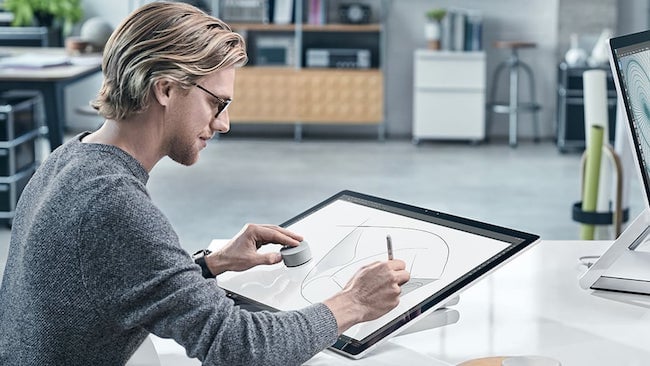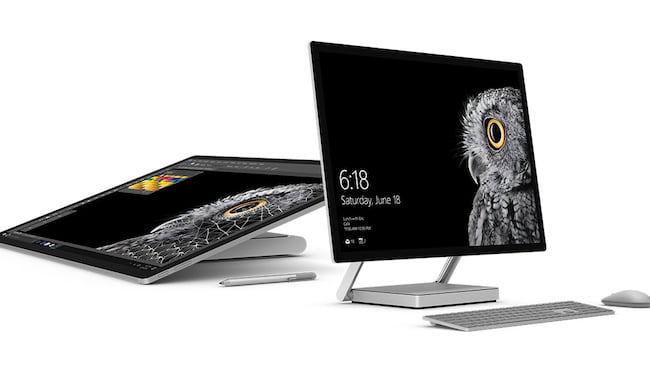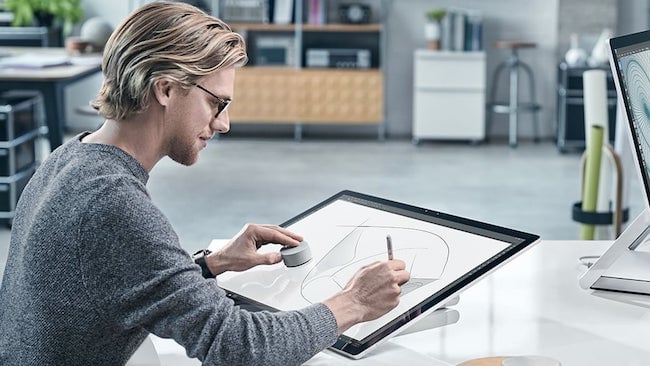
 The 20-degree angle is achieved using a 'zero gravity' hinge
The 20-degree angle is achieved using a 'zero gravity' hinge
Microsoft’s new $2999 and upwards Surface Studio features an ultra-thin, high-resolution touchscreen and innovative control gizmos that make it feel like something genuinely new in the world of computing.
Microsoft is, if nothing else, persistent. The world was rather indifferent to some of the early Surface tablets it produced, despite their having several interesting points to recommend them. The Surface line has always had competitive display technology and been more than reasonably slim and lightweight, although Microsoft did have a terrible habit of selling the very nice (and frankly necessary) covers as an optional extra at a price that seemed unnecessarily inflated.
Mainly, though, the interesting thing about Surface has been that at least some of them run Intel's Atom CPU, as opposed to the uniformly-adopted Arm processor that runs practically every other highly-portable device in the world, including both Android and Apple cellphones and tablets. Adopt a CPU that can run software compiled for Intel's instruction set, and suddenly, you have access to the world's largest library of high-quality software. The combination of Intel and Microsoft is interesting enough, but what's really valuable about it is that much of the world's best software is designed to suit that combination.
So, there's reason to be interested when Microsoft announce a new tabl... hang on. The Surface Studio, which the company unveiled in New York yesterday, is no tablet: the thing’s twenty-eight inches across the diagonal off its ultra-thin (12.5mm since you ask) touchscreen. Calling it the Surface Studio though hints at the company's intent: it's a ‘luggable’, something for the roving architect, musician or video editor on the go who'll need more than an iPad when they arrive. Or, perhaps just as likely, it's a super-minimalist desktop for people who like to pretend they live in the house on a beanpole from Oblivion.
As such it has some interesting new features, including a screen that will angle down to 20º when required so that it can be used as a drawing board, and the ability to switch between DCI-P3 and RGB colour spaces on the fly.
It comes with a Pen, but chief interest so far has been with its new control gizmo: the $99 Surface Dial. This hovers on the border between likeable innovation and sci-fi gimmick and is essentially a rotating puck made of wireless, brushed aluminium that incorporates haptic feedback and boasts ten points of precision per degree. You can use it on your desk to perform many mouse-wheel or Ctrl-Z like activities, but — and this is where it gets good — you can also use it on the display itself, where it will add functionality based on the app that’s being run and let you change colours without picking up your pen etc.

It kind of recalls the speculative user interfaces from Microsoft's Future Vision video series, but the fact that the whole thing is designed to be a pen-driven tablet makes that sort of graphical UI easier to implement, of course, and the 4.5 by 3K screen should certainly make for pleasant viewing. The only concern with the display is that, if a 32-inch monitor isn't really big enough to make a 3840-pixel wide image worthwhile, 4500 pixels on a smaller 28-inch display is not likely to be something anyone would want to operate without some sort of scaling switched on.
Prices start at $2,999 for a model that ships with a 6th-generation Intel Core i5 processor, 1TB of internal storage, 8GB of RAM and a 2GB GPU, while the ranges peaks at $4,199, which will get you a Core i7 processor, a 2TB storage disk, 32GB of RAM and a 4GB NVIDIA GeForce 980M graphics card. In other words, it’s not a workstation, although it's possibly the user interface to a remote resource if on-demand cloud computing keeps going the way it is. Given the spec and the attention to design detail, it'd be easy to describe this as Microsoft going after Apple's iMac range. That'd be a bit redundant, though: Apple and Microsoft have been gleefully going after one another for years, and it's only occasionally that Microsoft puts out something this clearly aimed at its arch-nemesis.
Pre-orders are open now and it’s slated to ship on December 15. Meanwhile, consider that it isn't very often that we see an organisation the size of Microsoft launch an entirely new class of computer. It's clearly not a tablet, though it's just as clearly built with tablet technology. It's perhaps most likely to compete with iMacs and the sort of desktop PCs that have been offered in that mould, but the combination of features is certainly pretty unique.
Tags: Technology



Comments